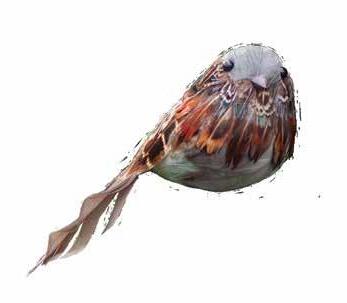

GARDENER
Independently owned and operated since 1996
PUBLISHER
Michael Cavanaugh
EDITOR
Elizabeth Cavanaugh
CONTRIBUTORS
Matt Bunch
Markis Hill
Glenn Hodges
Elizabeth McGinley
Anthony Reardon
Anne Wildeboor
Scott Woodbury
DISTRIBUTION
Publishers Delivery Solutions, Inc.
IF YOU WOULD
of business, please contact Mike Cavanaugh
mike@kcgmag.com 913-648-4728
NEED MORE MAGAZINES? mike@kcgmag.com 913-648-4728
CONTACT US P.O. Box 8725 Prairie Village, KS 66208 913-648-4728
ADVERTISING
Mike Cavanaugh at mike@kcgmag.com 913-648-4728
QUESTIONS ABOUT EDITORIAL AND SUBSCRIPTIONS
Elizabeth Cavanaugh elizabeth@kcgmag.com 913-648-4728
HOW TO SUBSCRIBE
See details on page 19.
WEBSITE kcgmag.com

An attitude of gratitude
Transitioning from summer to fall is tough, and lingering summer temperatures are of no help. Gardens and gardeners alike are unable to hide their weariness. The colors of autumn are slow to show, and I’m feeling a bit cranky and glum. In all honesty, this is my least favorite season.
The rain gauge is dusty. The foliage is dry and crispy. The search for caterpillars has ended. Butterflies and hummingbirds gone. Garden color is drab. In fact, if it weren’t for the containers awaiting cleanup there would be no color at all. Gardening feels a bit ho-hum. Yet, there’s work to be done, so I start with picking up branches and other debris from tree pruning. The professionals are excellent tree trimmers, and do a good job of picking up the big stuff.
As I stroll the garden, and before I know it, my hands are full. I make my way to the backyard fire pit, where these sticks and twigs will make good kindling for a cool evening fire. This little chore is not very taxing so I press on.
I remind myself that every garden looks like mine, in some form. And if you leave the leaves like we do, the garden will appear less tidy as fall and winter continue.
As I age, alongside our garden, I am learning to appreciate every season and the benefits each presents. For example, I came across this quote from Hal Borland, that lends a different perspective on this time of year. There’s more than what you see (crispy leaves, fallen branches and naked trees).
“We seldom think of November in terms of beauty or any other specially satisfying tribute. November is simply that interval between colorful October and dark December. Then, nearly every year, come a few November days of clear, crisp weather that make one wonder why November seldom gets its due.
There is the November sky, clean of summer dust, blown clear this day of the urban smog that so often hazes autumn...
There is the touch of November air, chill enough to have a slight tang, like properly aged cider. Not air that caresses, nor yet air that nips. Air that makes one breathe deeply and think of spring water and walk briskly.”
~Hal Borland, “Bright November Day,” November 1970
Harold “Hal” Glen Borland (1900-1978) was an American writer, journalist and naturalist. In addi-
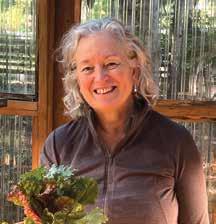
tion to writing many non-fiction and fiction books about the outdoors, he was a staff writer and editorialist for The New York Times. His words helped to bring the scenery of November into focus. And now my attitude is a little softer, a little quieter, more like the season of transition.
Let’s pause to give thanks for the people who enrich our lives, for the challenges that build us, and for the kindness bestowed upon us. As you approach the holiday season, may your heart be filled with love, laughter and happiness.

I’ll see you in the garden!















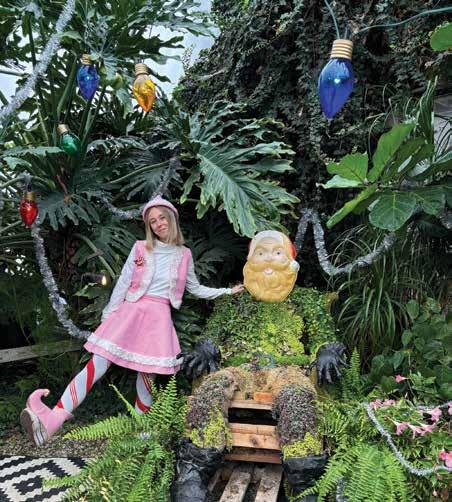

Camille Dungy Author of Soil: A Black Mother’s Garden
Dr. Abigail Lewis Executive Director of Citizens for Conservation
Keynote Speakers
Ask the Experts
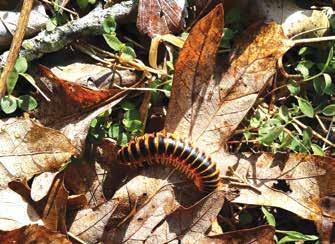
Most millipedes, like this colorful black-and-gold flat millipede (Apheloria virginiensis), feed primarily on decaying leaves, helping to recycle the nutrients into the soil.
LEAVE THE LEAVES EXPLAINED
Question: I heard about this ‘leave the leaves’ concept on social media. Won’t that kill my grass?
Markis’ Answer: Leaving the leaves has been trending in popularity over the past few years as a recognition of the importance of providing habitat for our native wildlife. Planting host plants for some of our native butterflies is excellent, but it means very little if those caterpillars do not have a place to overwinter.
To avoid killing your grass, there are a few things you can do. First, don’t leave a large pile of leaves on your grass. A big pile of anything that blocks light and air movement will kill the grass underneath. Additionally, if the pile is too large, the leaves can begin to decompose, which raises the pile’s temperature and disrupts the hibernating insects’ metabolism. The trick is to have a thin layer of leaves, one to three inches, allowing some grass to peek through still.


The process to clean tools is simple, broken down into five steps: cleaning, disinfecting, sharpening, oiling, and storing.
Strategically place your leaves in an area that is not your lawn. If you are concerned about your grass, place your leaves in areas with bare spots in your yard. Large shade trees often have little vegetation around their base, making them an excellent place to put your leaves. This has the added benefit of acting as a mulch layer.
Even though leaving the leaves will help native insects overwinter, they can also help diseases to overwinter. If you have a tree or shrub that is showing signs of disease, such as apple scab, bacterial leaf blight, Dothistroma needle blight, anthracnose, black spot of roses, or septoria leaf spot, removing and discarding the leaves at the end of the season is the best practice. Without removing these infected leaves, you risk reinfection from the spores of these diseases when the spring rains fall. Once a tree or shrub is susceptible to a particular disease, it will always be vulnerable.
The habitat must be present well into the spring season. Insects require consistent temperatures within their preferred range to emerge from dormancy. In the spring, wait to do anything with the leaves until temperatures remain above 50°F for multiple weeks. This will allow most of the insects to emerge safely. After waiting as long as possible, you can mow and mulch all those leaves into your lawn. This replenishes nutrients in your lawn, reducing the need for potassium and phosphorus fertilizers.
GARDEN TOOL CARE
Question: I want to take better care of and preserve my garden tools after this growing season, but I’m unsure how. Any suggestions?
Anthony’s Answer: Late fall is the perfect time to clean and preserve garden tools, as the process helps mitigate their components’ degradation in the winter. Luckily, the process is simple and can be bro-
ken down into five steps: Cleaning, Disinfecting, Sharpening, Oiling, and Storing.
Cleaning your tools, you can give the implements a more intense scrub than in the growing season. Remove all soil and ingrained silt particles, plant debris, and stuck-on sap during this. Generally, a stiff brush and warm, soapy water will suffice for the job, but harder spots may require steel wool if extra finicky. Remember, however, the more intense the scrubbing, the more likely wood, paint, or polycarbonate will be scratched. So do so with caution.
Disinfecting prevents the contamination of produce or the spread of fungi, viruses, or bacteria between plants. It should still be done at the end of the growing season, as pathogens can continue on surfaces for many months in the right conditions. Using a 10% bleach solution (1 part bleach to 9 parts water), spray implements after cleaning to help prevent diseases from being carried over to next year.
Tools are cleaned and sanitized, and you can then look to sharpening. Utilizing a metal file, be sure to sharpen the edges of pruners, shears, hoes, and shovels with the file moving outward away from you in long, broad strokes. Do not sharpen in a sawing motion, and follow the beveled angle of the blade edge, as not doing so will wear back the metal more quickly.
Finally, with oiling and storage, a light coat of mineral oil on metal helps prevent rust, and a linseed oil coating helps prevent wood degradation. Tools should be stored in a dry, sheltered spot, protected from winter elements.
ANTHONY REARDON | Horticulture Agents | MARKIS HILL
Anthony and Markis are the horticulture agents for Johnson County K-State Research and Extension, each specializing in edible crops and ornamentals, respectively. For free information fact sheets, visit www.johnson. ksu.edu, or call the Extension office at 913-715-7000.

Photo: Xerces Society, D.J. Weyer CC-BY-NC.
Free Speaker Series offered by Gardeners Connect Area Author to Share Enthusiasm for ‘Bugwatching’ at November Program

It is intriguing to watch wildlife in our gardens. An area insect expert encourages us to study the insects we share our gardens with in a newly published book. He plans to share his enthusiasm with us during the November Gardeners Connect Free Speaker Series program.
Entomologist Eric R. Eaton has a new title to add to his list of published books, Bugwatching: The Art, Joy, and Importance of Observing Insects. He is scheduled to discuss the book at Gardeners Connect’s Tuesday, Nov. 11, program at the Merriam Community Center. The free program will start at 7 p.m.
Insects are the most abundant wildlife on the planet but also the least observed. Bugwatching shares





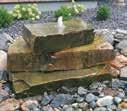
tips for attracting desirable bugs to your garden. The book and talk will help you better appreciate and understand insects and improve your success rate in finding, watching and identifying them.
Eaton, a resident of Leavenworth, Kan., has written or contributed to several books. He authored Insectpedia (Princeton University Press, 2022) and Wasps: The Astonishing Diversity of a Misunderstood Insect (Princeton University Press, 2021). He also was lead author of the Kaufman Field Guide to Insects of North America (Houghton Mifflin Co., 2007). He co-authored Insects Did It First (Xlibris, 2018).
He has contributed to other books, too, including The Butterfly Gardeners Guide (Brooklyn Botanic Garden, 2003) and Wild in the City: A Guide to Portland’s Natural Areas (Oregon Historical Press, 2000).
Eaton has a social media following on Facebook and Twitter as “Bug Eric.”
He studied entomology at Oregon State University and has worked as a professional entomologist at the University of Massachusetts, Amherst; Cincinnati Zoo; and Chase Studio Inc., as well as on private contract for the University of Colorado, Boulder; West Virginia Division of Natural Resources; and the Smithsonian.






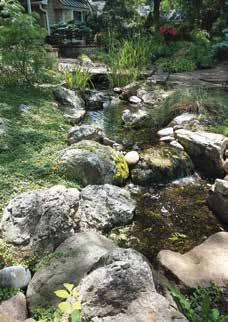

Locally owned & operated by Drew & Megan Diekmann

The simple act of choosing a pumpkin—whether to carve, cook, or bake with—often stirs warm memories of family connection, creativity, and the joy of gathering around the table. From smart selection to easy, wholesome recipes, here’s how to get the best flavor and nutrition from your harvest!
Selection
Choose well-shaped pumpkins that are firm and slightly heavy. They should have tough skin without any wrinkles or blemishes.
Nutrition
Pumpkin is a source of vitamin A, an antioxidant that can reduce your risk of heart disease and certain cancers, as well as protecting eye health. Pumpkin is also a source of potassium, vitamin K, magnesium and fiber. Potassium helps maintain healthy blood pressure, vitamin K and magnesium help build and maintain strong bones, and fiber

The Healthy Gardener Harvest to Health: Pumpkins
helps control cholesterol and keeps bowel movements regular.
Storing
In a cool, dry place. Whole unblemished pumpkins can be stored for 3 to 6 months at 45 to 50 degrees Fahrenheit.
How to Cook Fresh Pumpkin
First wash the pumpkin, or scrub with clean running water and a good vegetable brush; cut and remove seeds. Here’s how to prepare it for baking, mashing, or turning it into delicious seasonal dishes:
Oven Method: Cut the pumpkin in half (or into quarters if it’s large). Place the pieces cut-side down in a shallow baking dish. Bake at 350°F for 30 minutes to 1 hour, or until the fresh is tender. Scoop out the soft flesh and mash with a little butter- about 1 tablespoon per cup of cooked pumpkin.
Microwave Method: Place pumpkin halves or chunks in a microwave-safe dish. Microwave on high for about 15 minutes, or until tender. Mash or puree as desired.
Boiling Method: Peel and dice the pumpkin into chunks. Boil for 25 to 30 minutes, or until fork-tender. Drain and mash or use in recipes.
Serving Ideas
Mash and spread on toast, then sprinkle with cinnamon or brown sugar.
Savory Soup Base: Puree and use as a creamy, nutritious base for soups.
Guiltless Pumpkin Pie
SERVES 8
INGREDIENTS
2 large eggs
1/2 cup white sugar
1 1/2 teaspoons pumpkin pie spice; Or use 3/4 teaspoon ground cinnamon and 3/4 teaspoon ground nutmeg
1/4 teaspoon salt
1 can (15 ounces) pumpkin or pumpkin puree
1 can (5 ounces) fat-free evaporated milk
Nonstick cooking spray
INSTRUCTIONS
• Preheat the oven to 350°F.
• Lightly grease or spray a 9-inch pie plate with nonstick cooking spray and set it aside.
• Crack the eggs into a large mixing bowl and beat them well using a fork or whisk.
• Add the sugar, pumpkin pie spice (or cinnamon and nutmeg), and salt to the eggs. Stir until the mixture is well combined.
• Stir in the pumpkin and evaporated milk until smooth.
• Pour the mixture evenly into the prepared pie plate.
• Bake for 40 to 45 minutes, or until the center is set and a knife inserted near the center comes out clean.
• Remove the pie from the oven and let it cool on a wire rack.
• Serve immediately or refrigerate until ready to serve.
Optional: Top each slice with 1 tablespoon of low-fat whipped topping and a light sprinkle of cinnamon before serving.
NUTRITION INFORMATION
Calories: 417, Total Fat: 20.5g, Saturated Fat: 9.5g, Sodium: 406mg, Carbohydrate: 46g, Fiber: 3.5g, Protein: 13.5g
Source: Spend Smart. Eat Smart. - Iowa State University Extension
For Baking: Use mashed or pureed pumpkin in pies, muffins, or pancakes.
ELIZABETH MCGINLEY Field Specialist
If you want a healthier pumpkin pie, here is a recipe for you to try.
Want to learn more about seasonal vegetables and fruit in Missouri?
Visit the website seasonalandsimple.info for tasty recipes; infor-
mation on selecting, storing, and preserving produce; and to find farmer’s markets near you!
As always, our team of MU Extension nutrition and health specialists invite your feedback, questions, and topic ideas so that you can help shape the future of these articles!
Elizabeth McGinley is a Field Specialist in Nutrition and Health Education with the University of Missouri Extension. She offers programming related to healthy eating, physical activity, and overall wellness in the Kansas City area. Email her at emcginley@missouri.edu for more information.

Offering houseplants, herbs, annuals, perennials, roses, fruits, vegetables, fresh cut flowers, florals for all occasions. Delivery on Florals is available.
Located at 33607 E 199th St, Pleasant Hill, MO Take the second entrance off the main road. www.paulas-petals.com • 816-929-0522








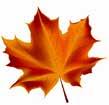
for
Shrubs, Perennials, Houseplants, Succulents, Bulbs, Pest & Weed Controls, Birding, Pottery, Containers, Tools, Watering, Fertilizers, Flags & more 60-70% off! Excludes macrame & holiday/ Christmas plants & merchandise.

Amaryllis, Greenery & Poinsettias (late Nov). Peaceful country setting, low sales tax rate, cats + Maggie


1430 Hwy. 58, LeRoy KS 66857 lbpavlak@gmail.com Sun 1 - 5 pm * Follow us on Facebook *











Don’t Sleep on Narcissus… Time to Plant Your Spring Bulbs

Fall is such a beautiful time in the garden. As gardeners, we are winding down after a summer of hard work, just like the plants. So the prospect of planting bulbs in the fall is sometimes too big of a pill to swallow. But I guarantee you, the extra effort is so worth it in the spring. Whatever your bulb of choice is, it will bring beauty and happiness to your garden. Though it seems that certain bulbs get all the hype…tulips, while others that have beautiful flowers and excellent garden attributes…daffodils, get overlooked.
Daffodils or jonquills are the common names of the genus Narcissus. Narcissus was a mythological character, and the related concept of narcissism all stem from the Greek legend where the beautiful youth Narcissus pined away after becoming obsessed with his own image,

eventually being transformed into the flower that now bears his name. Narcissus bulbs are a cost effective, long term, pest free perennial plant for your garden. They do best in full sun or at minimum part sun. Well drained soil is preferred, if soil is too wet they may not flower as well.
The American Daffodil Society separates Narcissus into 13 divisions or categories. Miniatures are now their own category, but not counted as one of the 13, so let’s just say there are 14. At the Overland Park Arboretum & Botanical Gardens we have specimens from each division. Each division is unique in its own way and I think it is so important to highlight how diverse this genus is.
Trumpet daffodils are Division 1, they have one flower to a stem and the cup is as long or longer than the petals. These bulbs are usually bigger than other divisions and they
perform extremely well in our Zone 6 climate. ‘Rijnvelds Early Sensation’ is my beacon in the garden that spring is coming. This bright yellow daff is the first to bloom of all the Narcissus varieties we have. Usually showing its sunny face in mid-tolate February. I walk to the Erickson Water Garden and check to see if it’s blooming each week in February, never knowing when it will be waiting for me. ‘British Gamble’, ‘Las Vegas’ and ‘Pistacho’ are a few of my other trumpet favorites.
Division 2 is the Large Cup Narcissus. They are also one flower per stem and have a cup that is more than one third or equal to the size of the petals. ‘Ferris Wheel’ is such a bang for your buck bulb. The flowers are very large, with golden yellow petals and a huge ruffled orangish cup. They are an absolute show stopper in the landing beds at the bottom of the Great Lawn near Margaret’s Pond.
The opposite of the second Division is the Small Cup, which is Division 3. Two of my favorites to use to compliment spring annual plantings are ‘Falmouth Bay’ and ‘Polar Ice’. Both are pure, clean white with no yellow tinge. They withstand spring weather well and have sturdy stems.
I think Division 4, the Double Division, is so feminine and gorgeous. ‘Tahiti’ is a classic double variety that we get so many questions about. It is bright and cheery, with soft yellow petals and a ruffly deep orange center. It really is like a happy, tropical cocktail on the beach. I also appreciate that it is a
late bloomer, so it extends our daffodil season sometimes into late April. ‘Erlicheer’ has multiple small double creamy white blooms on one stem. The bonus is they have a sweet fragrance. Look for them this spring in the Monet Garden.
Triandrus is Division 5, there are usually two or more pendant flowers per stem. ‘Thalia’ is a consistent perennializer that sports clean white flowers and a light fruity fragrance. This is one of the main reasons they are planted at the entrance of our Longhouse Visitors Center. They will compliment any spring annuals or other bulb colors we pick and the scent perks your senses up.
The petals in Division 6, Cyclamineus are reflexed. I think they look like what my hair looks like in a wind storm. ‘Rapture’ is a great representation of this division. With canary yellow blooms and a long narrow cup and petals that are going backwards away from it.
This is where things get confusing to some. Division 7 is Jonquilla, so the common name that some people/regions use frequently is actually a division.
This division has one to five flowers per stem and the petal segments are usually spreading. They are also usually fragrant, so plant them near entrances or patios where you and your guests can enjoy them. I admit I did buy ‘Cosmopolitan’ for the name, but it truly is a gorgeous flower, white petals with a blush pink cup that fades to a buttery yellow in the center and it is so sweetly fragrant.
Anne
is long-time horticulturist at the Overland Park Arboretum & Botanical Gardens. She loves sharing her passion for plants with the public and working alongside dedicated staff and volunteers.
Photos courtesy of Mark Stuecheli.
ANNE WILDEBOOR Horticulture Supervisor
Wildeboor,
Tazetta, Division 8, are the workhorses of the Narcissus world. They can have three to 20 flowers per stem! I am excited to add ‘Kapiti Peach’ to our collection. We will be planting this fall for visitors to enjoy next spring. I was intrigued by its white petals and peachy pink cup. It will look great with Merlot lettuce and peach Snapdragons.
One of the funkiest divisions, Split Corona, is Division 11. Basically the cup of the Narcissus is split into segments and they are spread back to the petals. ‘Cassata’ and ‘Congress’ are two of my favorites. ‘Cassata’ is white with soft yellow and ‘Congress’ is bold with golden yellow petals and bright orange cup. Both are statement flowers that are showstoppers in the landscape.
Division 12 and Division 13 are “other daffodils” and only distinguished by botanical name. Basically the ones in Division 12 stumped the botanists on where they should go and Division 13 are heirloom or species varieties. Narcissus x odorus flore pleno falls into Division 13, it is commonly known as the Queen Anne’s double jonquil. It is a bright sunny double yellow flower that is very fragrant and has

multiple blooms per stem. It is small in height, but packs a major punch when planted in large groupings. Miniatures are fast becoming some of my favorite Narcissus. Technically not a Division, but their own class shall we say. I love the diversity in flower shapes and textures. I love how dainty and sweet they are. I think they are great planted in mass under trees where you don’t have to plant them as deep as other daffodils and it creates a meadowy look. In our Train Garden, their small stature fits right in with our Gscale model train layouts. Here are my favorite minis, ‘Minnow’, ‘Sun Disc’, ‘White Petticoat’, ‘Twinkling Yellow’, ‘Rip Van Winkle’, and ‘Kokopelli’. They truly are the sweetest and you won’t be disappointed with these wee ones.
I hope you try some new Narcissus varieties in your garden this fall and enjoy them in the spring! There is a variety out there for you…I know it!
Editor’s note: All of the photos here are samples of Narcissus varieties throughout the Arboretum, meant to reflect varied flower shapes and sizes.

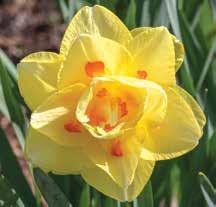
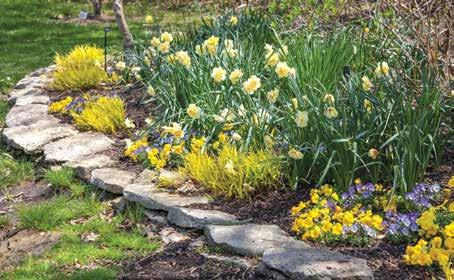

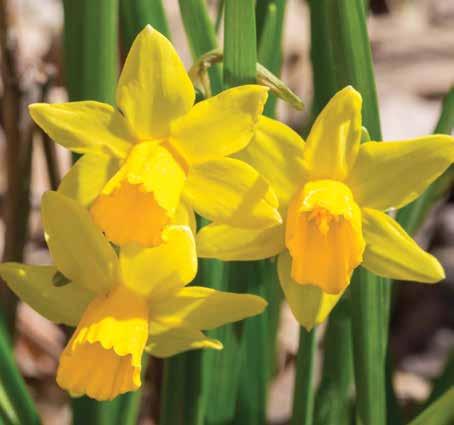
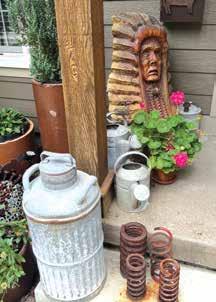

editor’s choice





A Passion for Garden Art
Note from the Editor: We recently talked with a neighbor who has a most fascinating landscape full of decorative elements. Strategically positioned throughout, the pieces are quite interesting and each bears a detailed story of origin. While many of our feature articles to date have been about plants, we thought you might enjoy this—a story of one man’s passion for garden art.
Gardens have long been places of sanctuary, respite, and connection. Inspired by na-
ture, the gardens we create are influenced by our personal preferences. Whether it is a country garden in the middle of the city, an English-style plot out on the prairie, or an inventive hybrid, the style and purpose is entirely up to us.
Beyond botanical beauty that comes from the trees and shrubs we select, there is the added aesthetic appeal established by garden art. Defined as any non-plant item intended to enhance the garden, garden art, too, is entirely up to us. There are functional pieces like benches and fountains, and decorative items like
statues and urns. Some are mementos and souvenirs from locations across the globe. Yet, for others, the selections are from times long passed.
Meet Sean Kavanaugh, a longtime resident and skilled gardener of Prairie Village, Kansas. Walk or drive past his home in the city, you can’t help but notice the landscape; it is like no other around town. The manicured lawn and clean edging is the ideal backdrop for this vast collection of garden art.
Kavanaugh’s fascination with all things vintage has been lifelong and
is attributed to his mother, a big antique collector. “I guess these things remind me of younger days with my family traveling across the country in the way back of the station wagon,” he recalls. Whether displaying old sprinklers from the 1930s or repurposing old clay water meter boxes into planters, it is a way to keep those memories alive.
Strolling through the garden you’ll spot bricks, hundreds of them, that are recycled to border garden beds and pathways, or assembled as stepping stones where the dogs created a mess. The bricks also frame
large 100-year-old grinding stones. A collection that spans 40 years, Kavanaugh has gathered bricks from locations around the area slated for reconstruction or demolition. He received one particular brick as a gift from a lady he met. The brick was engraved with this saying, “Don’t spit on the sidewalk.” In fact, he says that a large percentage of items collected have been freely given to him, or he was given permission to remove from the site. Among the bricks, too, are granite pavers once used as roadway materials in a nearby city long ago.
Retired now from a lengthy career with the gas company, he is likely to go hunting—for garden art, that is. Estate sales, flea markets, and swap meets are excellent places to score vintage pieces. You know that old adage, one man’s trash is another man’s treasure. An old bicycle, a metal glider, watering
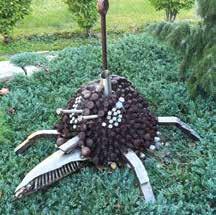
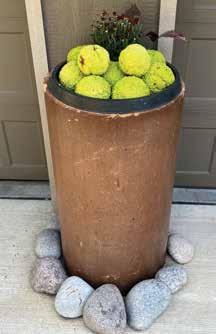
cans, milk cans, and springs from the seat of pastured farm equipment are all on display, providing fodder for conversations with visitors.
Some items in Kavanaugh’s collection were rescued from places like a dilapidated building scheduled to be torn down, and from a homeowner’s curbside junk pile, simply cast aside. Like a worn out lantern or Pepsi sign. His backyard fence is lined with livestock troughs filled with vegetable plants.
Then there are the objects he created. Kavanaugh has masterfully strung together electrical insulators used by the electric company long ago, and with the help from a friend with welding skills, fabricated a distinctive piece of art. He also has painted a large barn quilt that hangs on the side of his house.
Neighbors and passersby are impressed and intrigued by his gar(continued on page 12)
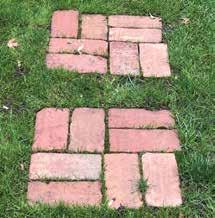

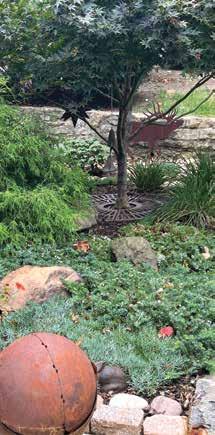
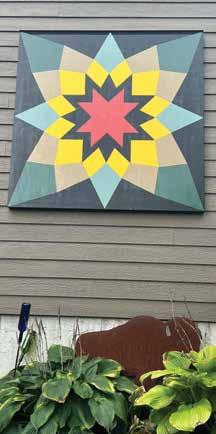
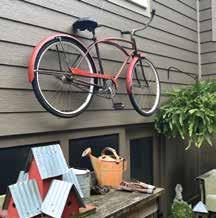
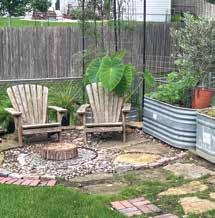
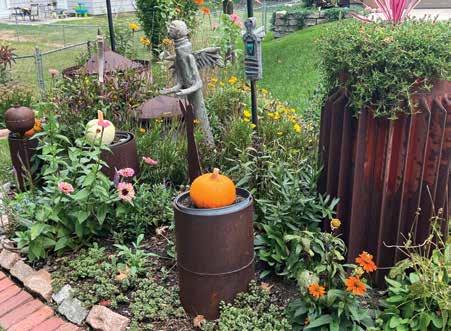
Garden Art
(continued from page 11)
den art. One person took the time to write this message:
“I regularly drive past your home & admire your well maintained & beautifully planned landscape. The solar system spinners are a nice touch, too. I thought I should let you know how much I enjoy this bright spot on my drive Thanks! Christine.”
Kavanaugh’s garden art is a reflection of connections, encounters with people he has met through the

years. Some old, some new, but all have treasured historical accounts. He is interested in the origin and function of these treasures, and spends a considerable amount of time researching and learning more. Understanding where they originated and what they were used for adds to the connection with each item. And when visitors tour his garden, he is able to share all that he has learned. All of this is part of this man’s passion for garden art.



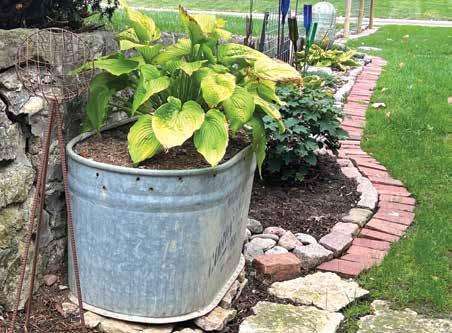
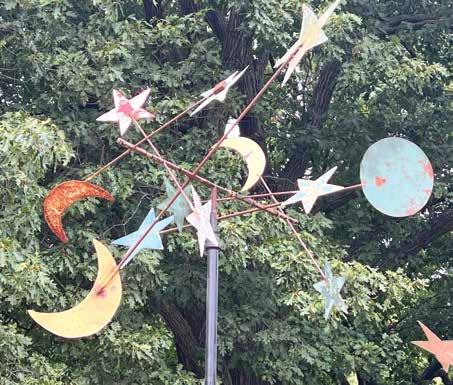
Of Orchards and Food Forests
It is November! Many of you may have just made the annual trek, a time-honored favorite activity, to the U-Pick orchard. Cold cider, hot cider, crisp days, the frost is on the pumpkin, the pumpkin might be frozen…and the squirrels are eating it. It is also tree planting time again! For me, most of the tree planting for the past 18 years has been fruit and nut trees, edible trees, orchard trees, perhaps even food forest trees. This begs the question: what is a food forest, and how does this compare to an orchard?
We all have a good understanding of an orchard; rows of similar fruit trees evenly spaced throughout the landscape with mowed walking paths between the rows. Community orchards, like the many that we have planted with the KCCG Giving Grove throughout the metro, are similar in structure, only smaller, on a community scale, typically on lots under a 1/8th of an acre, and with 12-20 trees. This is familiar, it is walkable, and relatively easy to maintain. Recently, especially the past 10 years, another concept has reached the zeitgeist, the Food Forest or Forest Garden. How does this differ from community orchard and are there commonalities?
What is a Forest Garden?
This seemingly could be a planting of ornamental shade loving plants, think hostas, azaleas and all of the usual understory. While you wouldn’t be wrong, the term is more associated with a utilitarian and edible garden, where the plants serve a purpose for not only humans but also benefit the soil, native insects, and the plant community as a whole.


Oyster mushrooms are an edible component of a local food forest.
The forest garden, in theory, mimics the natural systems of a natural forest ecosystem. The term “Food Forest” spawned out of “Forest Gardening”, which was inspired by tropical climates and the layers of seemingly infinite edible abundance. These forest gardening ideas were translated to the temperate climates of the British Isles by the author and gardener Robert Hart in not only his garden but in his 1991 book “Forest Gardening—Rediscovering Nature and Community in a Post-Industrial Age”. This work was the catalyst for many of the modern food forest writers and advocates.
Planning an edible forest garden, or food forest.
With any piece of land you must evaluate the existing vegetation, sunlight, slope, etc… From there you can develop a plan that is based on the 7 or 8 (Groundcover can be lumped or split from herbaceous) different vegetation layers that you want to establish. These layers include: Canopy, taller trees such as
MATT BUNCH
The Giving Grove
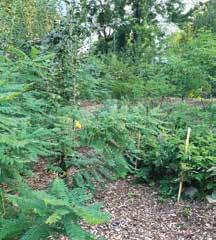
Nitrogen fixing Indigo bush (Amorpha fruticosa) with many fruiting plants in the background in a local food forest.
pecan, hickory, chestnut or low tannin white oak species; Understory, this is where many native and traditional fruit trees fit in; Shrub layer, currants, blueberries, brambles, other fruiting or nitrogen fixing (such as indigo bush) shrubs; Herbaceous, this layer can be edible/ medicinal perennials or annuals, pollinator plants, nitrogen fixing plants like clovers; Vines, annual or perennial useful vines; Root/Tubers, sunchokes, dandelions, licorice, burdock; and Fungus, edible, medicinal, and decomposing.
From planning to planting to maintaining.
There is the old adage “to know a plant you must grow that plant”. The more diverse you make a planting, the more knowledge is needed on how to maintain those plantings. Some plants may be pioneer species, some may spread and form colonies, some may become short-lived once shaded out, and then there are

A traditional community orchard in an institutional setting. This is functional, lacks biodiversity, but fits the site and the management constraints.
all the urban weeds that can invade a forest planting (White mulberries, poison ivy, honeysuckle, a-hem!). A forest can become impenetrable in a short time! When compared to a community orchard, a food forest can look like an unkempt weed patch. Luckily, there are now many books out there on food forests and permaculture that can be helpful in understanding these plant dynamics. It is our knowledge, understanding, and stewardship that can help these forests and our communities thrive.
For more information on Food Forests and Forest Gardens:
• Dave Jacke and Eric Toensmeier “Edible Forest Gardens” Vol 1 & 2
• Wayne Weiseman, Daniel Halsey, Bryce Ruddock “Integrated Forest Gardening”
• Plants for a Future (pfaf.org)
For information on larger scale Agroforestry:
• The Savanna Institute (savannainstiture.org)
• Univ. of Missouri Center for Agroforestry (centerforagroforestry.org)
Matt Bunch is The Giving Grove program director for Kansas City Community Gardens and Horticulturist for The Giving Grove’s national network. For more information about Kansas City’s Giving Grove program, visit www.kccg.org/giving-grove.

Diarrhena obovata
American beakgrain
Photos by Scott Woodbury.
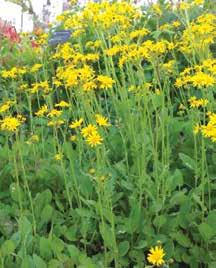
Packera plattensis
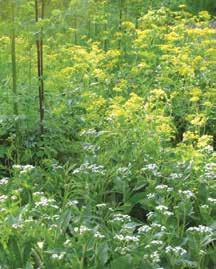
Parthenium hispidum, Zizia aurea, and Thalictrum revolutum
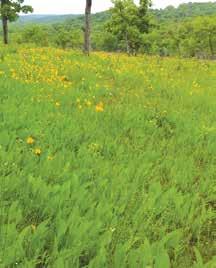
Parthenium hispidum
Spreading Plants Find Their Niche in the Natural Garden
Some plants have evolved to spread and survive in the wild, primarily through the use of rhizomes (stems that spread underground). American feverfew (Parthenium hispidum) and ashy sunflower (Helianthus mollis) notoriously produce few flowers when mature. They use more energy for rhizome and root growth than flower and seed production, a niche strategy that produces great results in nature, and possibly great results in the garden, if you are looking to plant, for instance, a dense ground cover on a difficult hillside. When I see massive patches of ashy sunflower in tallgrass prairies, it’s obvious that something is working for this plant. The same is true of American feverfew, which colonizes in dry glades.
But most gardeners are more impressed by flowers than foliage. Lucky for us, there are spreading

plants available in nurseries that bloom nicely, like prairie groundsel (Packera plattensis), a yellow-flowering, nearly evergreen plant that can be grown as a short, solid ground cover in shade or full sun, though I prefer to weave it with small to medium-sized sedges (like star sedge, Carex radiata and palm sedge, Carex muskingumensis). Keep in mind that when combining with other species in the garden, a few plants of groundsel (of any Packera species) will go a long way. They are clumpforming in year one, then explode from rhizome growth by year two. It may be worth planting the sedges and other low-growing perennials in year one, and then the groundsel in year two.
Wild strawberry (Fragaria virginica) is very similar—and aggressive as can be—though its stems spread aboveground (stolons). Be-
SCOTT WOODBURY Horticulturist
cause of this, wild strawberry can be controlled by cutting off new-grown stolons in early summer when they appear. This is not an easy task, because the stolons appear repeatedly throughout the growing season. It’s better to introduce it with other plant species in year two or three, after the other plants are established. Wild strawberry will then weave itself into gaps and not take over.
Another one that performs this way, but not nearly as assertively, is American beakgrain (Diarrhena obovata), a shade-loving grass with dark green shiny leaves in summer and attractive tan leaves in winter. It isn’t as aggressive as groundsel, and may take three seasons to start
suckering. You could grow this as a ground cover, but I like to add other woodland species between it, like Jacob’s ladder (Poleminium reptans), sensitive fern (Onoclea sensibilus), wood poppy (Stylophorum diphyllum), and blue-stem goldenrod (Solidago caesea).
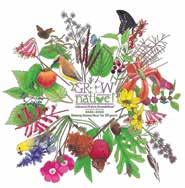
When I mention common milkweed (Asclepius syriacus), half the time the response is “no thanks.” Gardeners know that this plant spreads. I found a couple of tricks that make common milkweed easier to manage. One is to plant it in half-day shade or part shade to slow it down. (If you want it to grow like crazy, plant it in full sun). The other is to introduce it after the garden is estab-
Scott Woodbury was the horticulturist at Shaw Nature Reserve for 30 years and stepped down from that position in June 2022. He continues to work on contract for Shaw Nature Reserve to carry out native landscaping education and launched his own business called Cacalia: Native Garden Design and Wilding. Find suppliers of native plants and seeds, as well as landscaping services, at grownative.org.
lished. Though common milkweed can send rhizomes out 3 to 5 feet in any direction, it seeks out the gaps in the garden. It’s also easy to pull up unwanted stems when they are waist-high. If you are trying to cover a steep sunny hillside with solid vegetation, try common milkweed with little bluestem (Schizachyrium scoparium) and sideoats gramma (Bouteloua curtipendula). Add some ashy sunflower or American feverfew for a rock-solid hillside planting that will only need to be cut down once a year to keep the trees out.
Lastly, if you have a lot of space and need to cover a large area with plant material, you might consider
winged or smooth sumac, two shrubs that spread quickly by rhizomes. Winged sumac (Rhus coppalina) can grow 8 to 10 feet tall and wide. Smooth sumac (Rhus glabra) can reach 15 feet. The brilliant, orange and red fall color can’t be beat, and looks great with big native grasses like big blue stem (Andropogon gerardii), or switch grass (Panicum virgatum), and big perennials like Arkansas blue star (Amsonia hubruchtii) and aromatic aster (Symphyotrichum oblongifolium) that combine into, what plantsman Larry Lowman used to call a wild orgy of color in autumn.
Happy gardening y’all!









We have a great selection of fresh Christmas decorations & flowering plants. festive poinsettias • holiday décor fresh cut trees • fresh garlands & greenery unique gifts for that special gardener













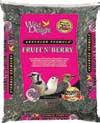



Upcoming Garden Events

Garden Club of Shawnee
Thurs, Nov 6, 7p; at Shawnee Town 1929 Town Hall, 11600 Johnson Dr, Shawnee, KS. Our November meeting will be pizza night. We will enjoy a night of bingo led by member Nancy Hammond. Prizes will be awarded to the winners. As always, Visitors are welcome!
Kansas City Cactus and Succulent Society
Sun, Nov 16, 1:30-3:30p; at the Trailside Center, 9901 Holmes St, Kansas City, MO. Starting with this November meeting we will begin a plant challenge. Each club member will receive the same succulent plant to take home. We will compare our growing and maintenance successes at three months and six months with discussions about the type of soil mixture we used if we repotted our plant, our watering and fertilizing schedule, sun exposure conditions, and our individual care nuances. Photos taken monthly would be great for comparison. Anyone is invited and refreshments will be served.
Leawood Garden Club
Tues, Nov 11, 10:30a Club Meeting and 12:00 program begins; at Cure’ of Ars Catholic Church, 9401 Mission Rd, Leawood, KS 66206. Program: “Designs For Your Holiday Table” by Becky Miller. Becky has been designing floral arrangements now for 50 years! In 1987 Becky earned the title Master Florist. That program no longer exists, but Becky is still proud of that title.
Raytown Garden Club
Tues, Nov 4, 10a; at Blue Ridge Presbyterian Church, 6429 Blue Ridge Blvd, Raytown, MO 64133. Program will be “Planting in 2025:
Hits & Misses in Our Gardens” presented by a Round Table Discussion by RGC Members. Guests are always welcome. For more information please check out our Facebook page: https://www.facebook.com/ RaytownGardenClub
spring. If accommodations are needed, please e-mail the instructor at least one week prior to the program. https://mdc.mo.gov/events
Birds: Project FeederWatch 2025: Discovery Center Kickoff
Sat, Nov 1, 10-11:30am; at Anita B Gorman Conservation Discovery Center, 4750 Troost Ave, Kansas City, MO 64110. Walk-in (ages 6+)
Discover the joy of birdwatching with us as we launch this year’s project FeederWatch! We’ll start with a fun, hands-on introduction to learning how to count and record feeder birds, then head outside to make our very first observation together on the official opening day. come curious and ready to spot feathered friends - you might be surprised at who shows up! If accommodations are needed, please e-mail the instructor at least one week prior to the program. https://mdc.mo.gov/events
Native Plants: Native Landscape Chat: Autumn Garden Walk Fri, Nov 7, 1-2p; at Anita B Gorman Conservation Discovery Center, 4750 Troost Ave, Kansas City, MO 64110. Registration required by visiting www.deeproots.org/guidednature-tour (ages 12+) Fall is in full swing but there’s much to appreciate in the landscape. Join Deep Roots and the Missouri Department of Conservation for an autumnal walk across the gardens of the Discovery Center to learn more about native plants that provide food and habitat for wildlife. Get inspired by sculptural seedheads and learn which plants to add to your garden next
African Violet Show and Sale Sat, Nov 8, 9a-2:30p; at Loose Park Garden Center, 51st St and Wornall Rd, Kansas City, MO 64112. Presented by African Violet Club of Greater Kansas City, 73th Annual Show & Sale “Three Trails of Violets”. NO ADMISSION FEE
Heartland Peony Society Sale Sat, Nov 8, 9:30a-3p; at Asbury United Methodist Church (75th & Nall). Get ready to enhance your garden with some stunning new additions at the Heartland Peony Society biennial sale. The sale will continue until all our roots are gone, so be sure to arrive early! This year, you can grab a special variety value pack featuring three distinct peonies. We’ll also have a wide selection of rare, hard-to-find colors and a wonderful collection of both Herbaceous and Intersectional varieties. We can’t wait to see you there!
Christmas Open House Sat, Nov 8, 9a-4p; at Green Streets Market, 112 E Green St, Clinton, MO 64735. Decorate for the holidays. Fresh cut Fraser firs, decor, wreaths, garland and greenery planters. Refreshments. Also, join us for the 8th Annual Merry Main Street, our downtown holiday open house shopping event! Sweepstakes. Great shopping. 660-885-3441
Mizzou Botanic Garden Lecture
Thurs, Nov 13, 6:30p; at Cornell Hall, Bush Auditorium, 700 Tiger Ave, Columbia, MO. Mizzou will be hosting a lecture featuring Bill Quade, Director of Gardens and Grounds and will be speaking about
the miraculous recovery of the Biltmore Estate following Hurricane Helene. He will also be discussing what it takes to maintain the grounds of the largest private home in the United States. The lecture is free and open to the public. Questions, contact Karlan Seville, 573-882-3290.
Earth
Keepers
Sat, Nov 15, 10a-2p; at Lakeside Nature Center, 4701 E Gregory Blvd, Kansas City, MO 64132. Join Lakeside Nature Center for a wildlife event to learn how to be an earth keeper and support wildlife and habitats. Participate in a scheduled guided hike, come indoors to learn about initiatives to support wildlife, and meet a broad-wing hawk. The Master Gardeners of Greater Kansas City Children’s Programs will be presenting a fun activity. For more information visit https://www.independencemo.gov/events/21st-annual-winter-solstice-torch-lit-hike
Christmas in the Village
Sat, Nov 15, 6-9p; at Swan’s Water Gardens, 4385 W 247th St, Louisburg, KS 66053. Bring your friends to enjoy the Swan’s Village to start off the holiday season. Christmas lights and music. Cookies. Smores stations. Hot Cocoa bar. Photo ops. Free event and open to the public. 913-837-3510
Plantaland Pop-Up Tropical Holiday Mall!
Sat, Nov 29, 9a-5p and Sun, Nov 30, 11a-4p; at Vinland Valley Nursery, 1606 N 600 Rd, Baldwin City, KS 66006. Vinland Valley Nursery becomes a winter wonderland filled with fresh-cut Christmas trees, wreaths and roping from Kansas and North Carolina! Pick up wreaths and roping, order professional holiday family photos and holiday cards,
CLUB
SHOWS | OPEN HOUSES | MORE
make DIY holiday crafts for all ages, and enjoy snacks in the Botanical Coffee Shop & Food Court. Always held the weekend following Thanksgiving, Plantaland includes local artists and makers in a tropical holiday market. Support small local businesses and independent vendors on Small Business Saturday and pick up decorations and unique gifts to delight friends and family.
22nd Annual Winter Solstice Torch Lit Hike
Thurs, Dec 4, 5-7p; George Owens Nature Park, 1601 Speck Rd, Independence, MO 64057. The Annual Winter Solstice Torch-Lit Hike is a great option for those outdoor enthusiasts. We invite you to enjoy the changing of the seasons as you walk through the beauty of George Owens Nature Park. Feel the warmth from the campfire as you celebrate the winter solstice. Walk a paved trail lit by torches and enjoy live birds of prey, ice sculptures, and hot chocolate. Complimentary travel mugs in limited quantity. Master Gardeners of Greater Kansas City will be present to provide gardening information. For more information visit https://www.independencemo.gov/ events/21st-annual-winter-solsticetorch-lit-hike. Free program for all ages.
Luminary
Walk
Select nights Nov 26 through Dec 30; at Overland Park Arboretum & Botanical Gardens. Featuring adultsonly nights, crowd-free electric glow nights, and new this year, accessibility-friendly glow cart tours. Visit
OPABG.ORG for more information and to purchase tickets.
Plan It Native Feb 10-11, 2026 at Kauffman Conference Center and Anita B Gorman Discovery Center. Registration now open. Full Access Ticket Price: $315. 21 Concurrent Sessions and a Vibrant Exhibit Hall. Native Landscape Design and Maintenance. Native Bee and Butterfly Conservation. Prairie Restoration Projects. Keynote Speakers: Camille Dungy, Author of Soil: A Black Mother’s Garden; Dr Abigail Lewis, Executive Director of Citizens for Conservation. Learn more and register at PlanItNative.org.
CLASSES
Evergreen Wreath Making Sat, Nov 22, 1p; at Vinland Valley Nursery, 1606 N 600 Rd, Baldwin City, KS 66006. Learn how to make an evergreen wreath from scratch. We will go through the whole process. You will leave with a beautiful finished evergreen wreath and all the info you need to keep creating your own handmade wreaths. All basic materials and tools provided, plus a hot chocolate! $65/person. Please dress for the weather (we will take a walk outside to gather materials) and bring gloves if you wish–some of the greens can be a little hard on bare hands. Wreath building takes some time, so plan to spend at least 2 hours with us for this workshop. Register online at vinlandvalleynursery.com.
Planters Seed Co.




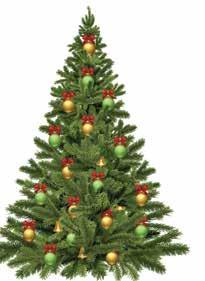


GARDEN CALENDAR
November list of what to do in the garden.
LAWNS
• Continue to mow as long as the grass is still actively growing.
• Second-best time to fertilize cool-season lawns.
• Spray winter annual weeds.
• If no seeding is taking place, apply pre-emergent herbicide to prevent winter annuals. Irrigation may be needed to activate the herbicide.
• Irrigate when dry before freezing temperatures set in.
• Dormant seeding can start when temperatures drop below 40°F.
• Remove large piles of leaves from lawn areas by bagging and removing, mulching them into the lawn, or moving them to an area off turfgrass.
TREES AND SHRUBS
• Water newly planted trees and shrubs.
• Protect young plants from rabbit damage by wrapping them or making a wire screen.
• Continue to plant new trees and shrubs.
• Rake and remove diseased leaves to reduce reinfection in the spring.
• Check mulch layers and replenish to maintain a 2-to-3-inch depth.
• Prune dead or hazardous limbs.
• Do not prune spring-flowering trees and shrubs until after they bloom.
• Water evergreens to reduce winter injury in dry soil conditions.
VEGETABLES AND FRUITS
• Sort apples in storage and remove spoiled fruit.
• Clean and remove fallen fruit from around trees to reduce insects and disease next year.
• Treat peaches for peach leaf curl while dormant.
• Review garden notes about successes and failures.
• Start planning for next year.
• Take a soil test and make needed adjustments.
• Till garden soil and add organic matter.
• Plant a green manure crop such as winter wheat or rye for added organic matter.

• Remove all debris from the garden area to reduce insects and disease next year.
HOUSE PLANTS
• Check plants for insects such as aphids and spider mites.
• Keep plants away from heat vents and cold drafts.
• Locate plants about 1 foot away from windows to protect them from winter cold.
• Reduce or stop fertilizing until spring.
• Water as needed and avoid letting roots stand in water.
• Rinse to remove dust from leaves.
• Continue dark treatment of poinsettias for holiday blooming.
• Plant and water amaryllis bulbs for Christmas blooms.
FLOWERS
• Clean up rose beds to help reduce disease for next season.
• Remove frost-killed annuals.
• Till annual flowerbeds and add organic matter to improve soil health.
• Continue to plant spring flowering bulbs.
• Dig and store tender bulbs, cannas, gladiolus, dahlias, and others in a cool, dark, dry area.
• Cut back tall rose canes to 24 inches to prevent winter breakage.
• Mulch tea roses with a cone of garden soil about 6 inches deep over plant.
• Leave dead stems on perennials to provide nesting areas for native bees and pollinators.
• Wind-blown leaves in gardens provide a natural area for overwintering beneficial insects.
MISCELLANEOUS
• Clean and oil garden tools, sprayers, other equipment for winter storage.
• Drain garden hoses and sprinklers and store indoors for increased life.
• Start a compost pile with fall leaves.
• Turn compost pile to hasten breakdown.
Johnson County K-State Research and Extension recommends environmentally-friendly gardening practices. This starts by identifying and monitoring problems. Cultural practices and controls are the best approach for a healthy garden. If needed, use physical, biological or chemical controls. Always consider the least toxic approach first. Markis Hill is the horticulture agent for Johnson County K-State Research and Extension. For free information fact sheets, visit www.johnson.ksu.edu, or call the Extension office at 913-715-7000.
Rose Report
Which roses in your garden did well in 2025? Which roses did not do well? Which new roses do you want for 2026? Now that the weather is cooler and winter is coming, now is the time to answer these questions. The 2026 rose catalogues are available online and in print Take time to look at the catalogues and envision what a new rose or roses can add to your garden.
Before selecting new roses, an understanding of rose classification can be helpful. Classes of roses in existence before 1867 are known as Old Garden Roses (OGRs). Classes of roses introduced after 1867 are Modern Roses. These include Hybrid Tea roses which have beautifully formed blooms on long stems. Similar to the Hybrid Tea roses are Grandiflora roses which primarily produce sprays, defined as two or more blooms on a stem. These roses bloom in cycles every 6 to 7 weeks. Floribunda roses have smaller flowers in sprays, and they bloom continuously rather than in distinct cycles. Miniature roses produce both one bloom per stem and sprays. They are generally less than 1.5 inches in diameter. Miniflora roses also produce single blooms and sprays but are between Miniature and Floribunda roses in size. Miniature and Miniflora roses have distinct bloom cycles about every 5 weeks. Polyantha roses form clusters or sprays of many blooms about one inch in diameter.
Large Flowered Climbers form long arching canes which require support on a fence, trellis, arbor, pergola or other structure. Modern Shrub roses have recently been divided into three groups. The first are low growing, spreading Ground Cover roses. The


second group are the English-style roses. Roses bred by David Austen are the archetype of this style of roses, but many other breeders have followed his lead. The final group of shrub roses are the Landscape roses which include all shrub roses that don’t fit into the previous two groups.
Preparing Roses for Winter
After there have been several hard freezes, it is time to clean all the leaves and debris from around your roses and apply winter protection. In our area, roses need to be covered with 8 to 12 inches of organic matter. Mulch, chopped leaves, or even soil can be used to cover the roses. Remember to refresh or replenish the covering material in January. And don’t forget to water the roses if we have a dry winter. The roses need about an inch of moisture a month. A good rule of thumb is that a foot of snow will provide an inch of moisture. A sunny, warm day is the ideal time to water, if necessary.
You can find more rose care on our website: www.KansasCityRoseSociety.org. Click on the Grow Roses tab.
GLENN HODGES, Master Rosarian
Glenn is an Extension Master Gardener in Johnson County, KS, an American Rose Society (ARS) Master Rosarian, and an ARS Accredited Horticulture Judge. He has been growing roses in Lenexa, KS since 1974 and successfully exhibiting roses since 1998.
Hotlines for Gardeners
Extension Master Gardeners are ready to answer all your gardening questions.
CASS COUNTY
816-380-8194; Wed, 9am-noon; casscomg@gmail.com
DOUGLAS COUNTY 785-843-7058; dgcogardenhotline@gmail.com; Mon, Wed, Fri, 1-4pm
GREATER KANSAS CITY MISSOURI AREA
816-833-8733 (TREE); Mon-Fri, 9am-noon; mggkc.hotline@gmail.com
JOHNSON COUNTY, KS 913-715-7050; Mon-Fri, 9am-4pm; garden.help@jocogov.org
JOHNSON COUNTY, MO 660-747-3193; Wed, 9am-noon

LEAVENWORTH COUNTY 913-364-5700; Leave a message. A Master Gardener will contact you.
MIAMI COUNTY & LINN COUNTY 913-294-4306; Thurs, 8am-noon
WYANDOTTE COUNTY 913-299-9300; Mon-Fri, 9am-4pm
QUESTIONS ABOUT ROSES?
Ask a Rosarian; rosehelp@kcrosesociety.org; www.kansascityrosesociety.org
SUBSCRIBE TODAY
For convenient mail delivery, complete the form below and send with your check for $38.00. You will receive a one-year subscription.
Name:
Address:
City, State, Zip:
Phone:
E-mail: Where did you pick up The Kansas City Gardener?



Please enclose your check payable to The Kansas City Gardener and mail with this form to: P.O. Box 8725, Prairie Village, KS 66208 The Kansas City Gardener is published monthly Jan. through Dec.
Floribunda rose ‘Sunsprite’
Photo by Glenn Hodges.
Sale ends Nov 16th

Fresh & Fragrant
Real evergreen wreaths and roping are estimated to arrive in our stores the second week of November.
Choose from
Luxurious permanent evergreen wreaths and roping to last season after season — available now.
Available at Lenexa and Martin City stores only.

Plant Spring Now
Come gather your spring bulb collection and plant now — this fall — for a garden that greets spring with joyful color.
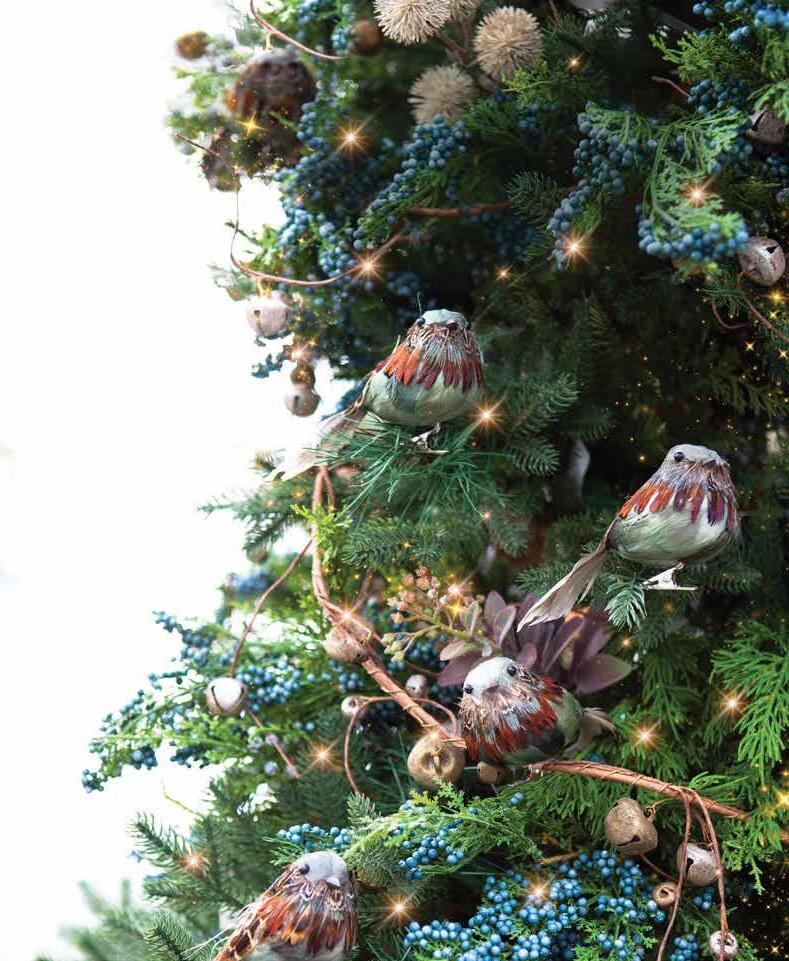
Brighten your home and set the scene for gatherings to come.
Find Inspiration
In a glittering assortment of unique tree decorations, home accents, and table décor.
